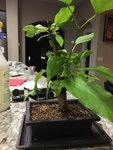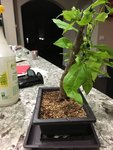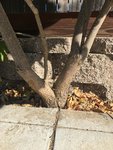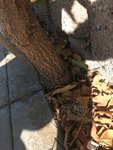sixemkay
Yamadori
Catalpa trees sprout up everywhere in my neighborhood, to the point that I consider them invasive. They have an interesting trunk texture, nice wide canopy, and seem indestructible... so I thought "why not dig one up and see what it can do?"
To start with, I dug it up after it had leafed out for the spring. Why? Because I didn't even notice the sapling growing there for the last year or two and it completely blended in with a fence line when it was bare all winter. I didn't want someone to remove the little tree before I could get to it next winter, so I dug it up and put it in a pot. This is an experiment anyway so let's see what happens...
The tree set one bud after a few weeks...

I let two sets of leaves just start to open and then I pinched out the first leaf set. That created back budding and within 4 days I had more leaves to pinch out.


The tree has been healthy and growing for 6 weeks now. I stopped pinching out the new leaflets about 4 weeks ago when I noticed that Catalpa does not respond to pinching out like an Acer Palmatum so I decided to stop doing it.
I've gone back and forth a lot about this tree. Sometimes thinking I shouldn't even bother with it (as advised by many people on these forums) and other times thinking "what have you got to lose?" at the very least you have something to "love to death" that isn't special and was totally free.
Last night I decided to check on the roots and wow... they were vigorous. I just got some "bonsai training pots" in the mail so I really wanted to do something...so I decided to do an ill-timed repot. It's an experiment right? At the worst I will learn a lesson: Don't do that again.
Please don't judge the canopy shape or branching....that part has a long, long way to go (and maybe it won't even be possible with this species?). I wanted to get a thread started on this tree because I have seen scattered questions out there about Catalpa and wanted to start providing documentation of my experience. Here are some pictures from last night, immediately after the repot...


And a pic I took this morning to show how small I was able to get some of the leaves. Wine cork for scale.
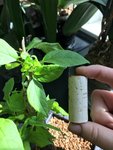
Thanks for reading!
To start with, I dug it up after it had leafed out for the spring. Why? Because I didn't even notice the sapling growing there for the last year or two and it completely blended in with a fence line when it was bare all winter. I didn't want someone to remove the little tree before I could get to it next winter, so I dug it up and put it in a pot. This is an experiment anyway so let's see what happens...
The tree set one bud after a few weeks...

I let two sets of leaves just start to open and then I pinched out the first leaf set. That created back budding and within 4 days I had more leaves to pinch out.


The tree has been healthy and growing for 6 weeks now. I stopped pinching out the new leaflets about 4 weeks ago when I noticed that Catalpa does not respond to pinching out like an Acer Palmatum so I decided to stop doing it.
I've gone back and forth a lot about this tree. Sometimes thinking I shouldn't even bother with it (as advised by many people on these forums) and other times thinking "what have you got to lose?" at the very least you have something to "love to death" that isn't special and was totally free.
Last night I decided to check on the roots and wow... they were vigorous. I just got some "bonsai training pots" in the mail so I really wanted to do something...so I decided to do an ill-timed repot. It's an experiment right? At the worst I will learn a lesson: Don't do that again.
Please don't judge the canopy shape or branching....that part has a long, long way to go (and maybe it won't even be possible with this species?). I wanted to get a thread started on this tree because I have seen scattered questions out there about Catalpa and wanted to start providing documentation of my experience. Here are some pictures from last night, immediately after the repot...


And a pic I took this morning to show how small I was able to get some of the leaves. Wine cork for scale.

Thanks for reading!

